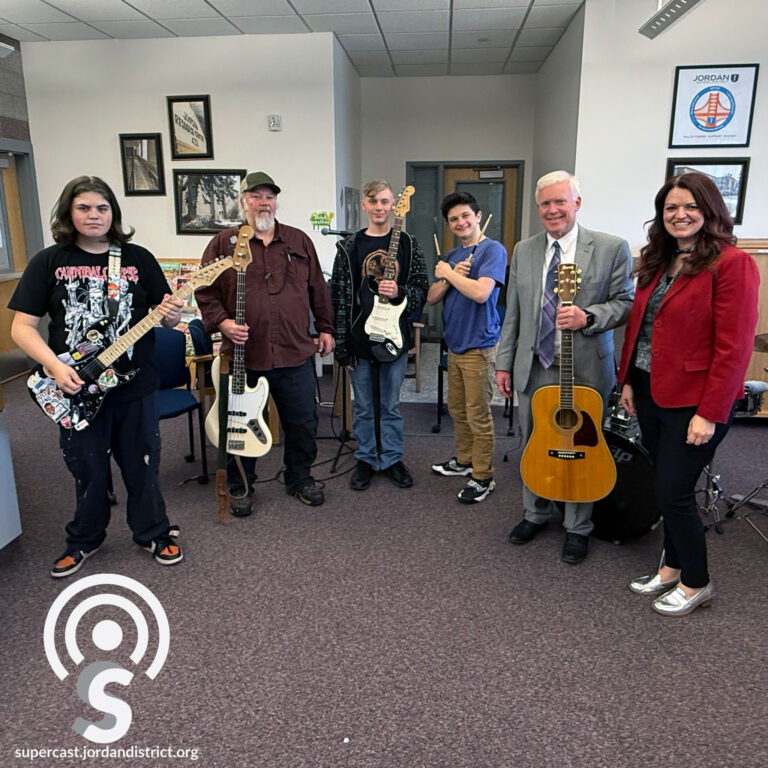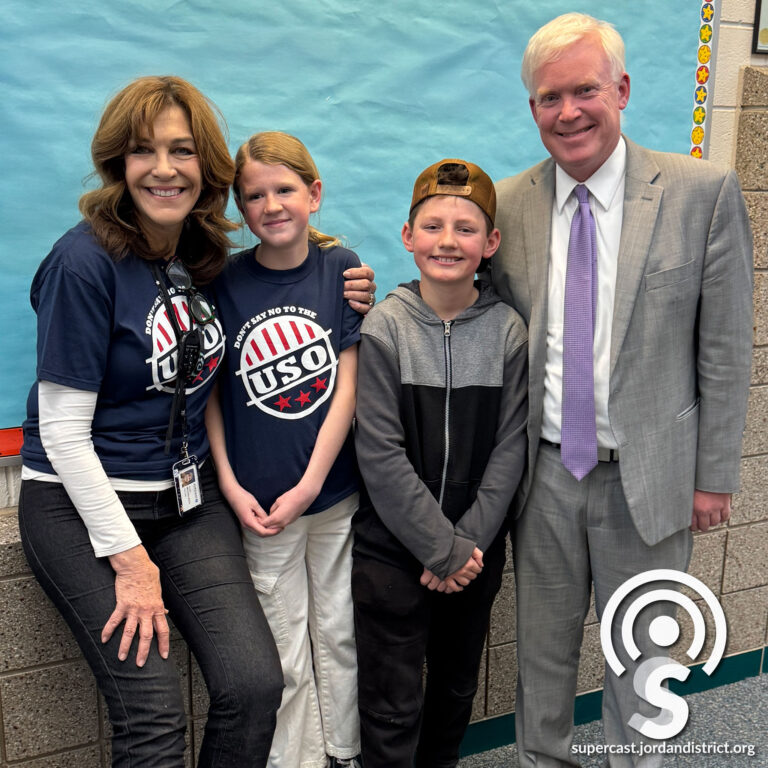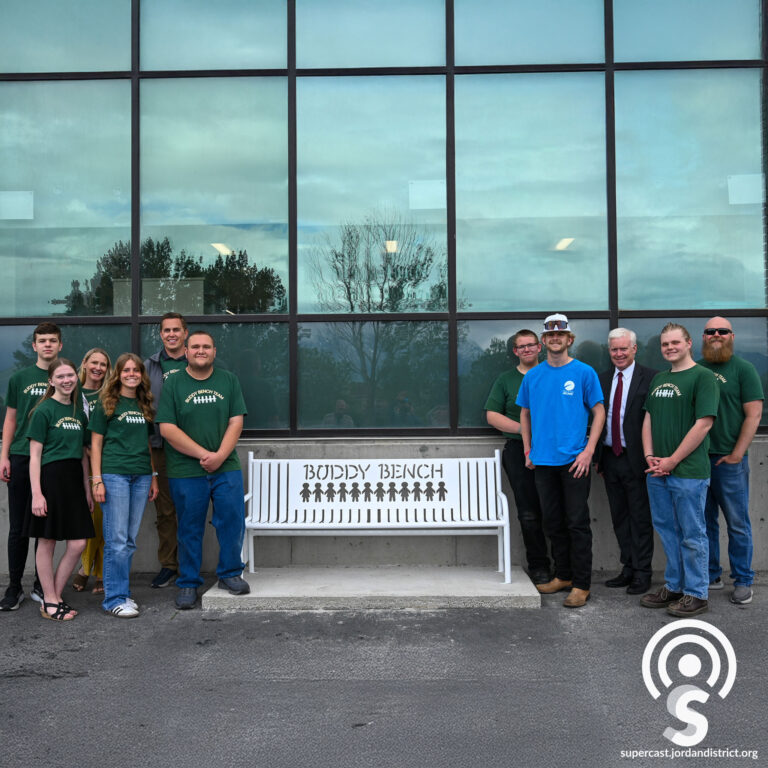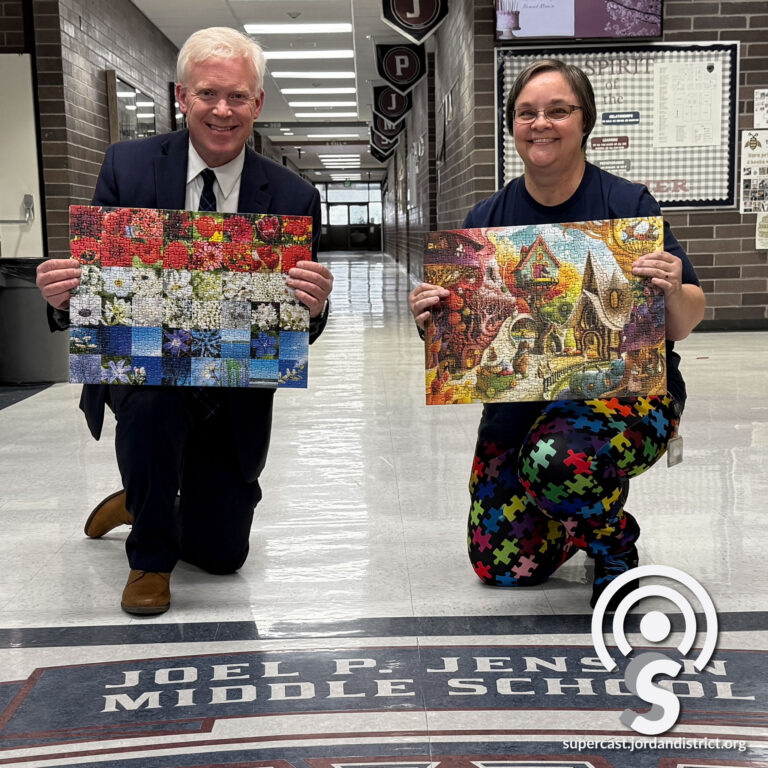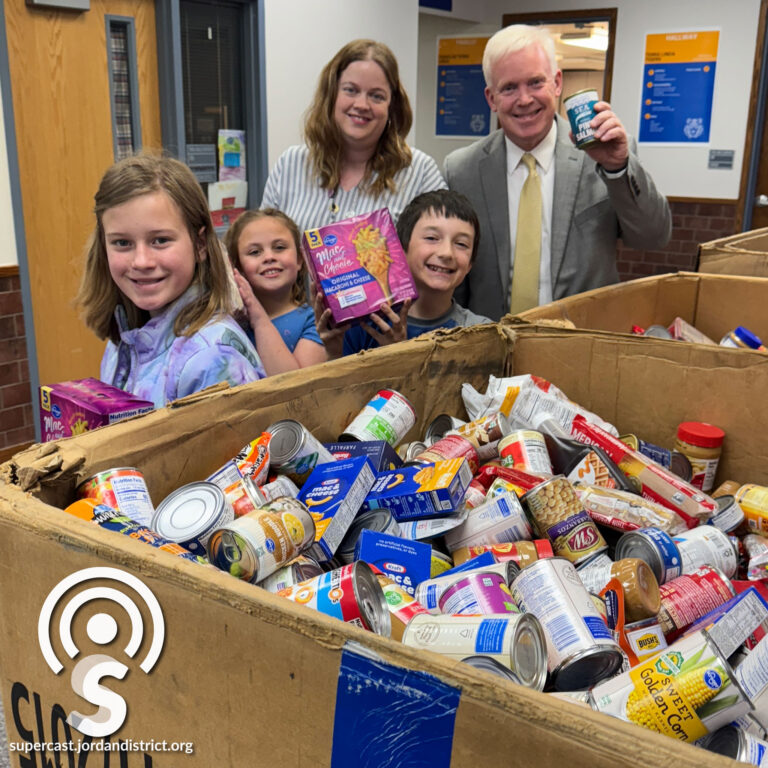You could say students are really ‘rockin it’ at River’s Edge School this year.
On this episode of the Supercast, find out how music in a brand-new school band is enriching the educational experience for students at River’s Edge and how teachers are taking note, loving the experience as well.
Audio Transcription
Melanie Dawson:
What's really tapped into developing skills that they may have already had somewhat, but to really expand that and give them this connection to school that might they might not have had before; something that they love and they love to come here for.
Eddie:
I was mad one day, so I just wrote a song.
Anthony Godfrey:
Yeah?
Eddie:
About how I was feeling.
Anthony Godfrey:
And when you wrote that song did you feel better after that?
Eddie:
Yeah, definitely.
Anthony Godfrey:
Hello and welcome to the Supercast. I'm your host, Superintendent Anthony Godfrey. You could say students are really rocking it at River's Edge School this year. On this episode of the Supercast, find out how music in a brand new school band is enriching the educational experience for students at River's Edge and how teachers are taking note, loving the experiences.
Anthony Godfrey:
We're here at River's Edge School talking with the principal. Tell us a little bit about the school and introduce yourself.
Melanie Dawson:
Hi, my name is Melanie Dawson. This is my third year as principal. I've been here six years as an administrator. River's Edge School is a school serving the students in the District who need the most intense social, emotional and behavioral support. They come here through a placement process and we have a lot of supports that exist throughout our building where we can provide them what they need and I take very seriously that this is their opportunity, not only to get some behavioral supports, but also this is where they get their education. So really making sure that we have as high quality and rigorous classes for them, so that the time they spend in our building, they are being educated at the highest levels possible.
Anthony Godfrey:
This is where students go to receive the most intensive support for social and emotional needs and behavior issues. Is that correct?
Melanie Dawson:
Correct. That is the population that we serve and they all come to us for a variety of reasons. We serve elementary through high school, so that is one thing that makes us unique. We have smaller numbers than they have at typical schools, but we have a huge breadth of the things that we do and the programs that we provide since we serve all ages.
Anthony Godfrey:
And a K-12 school means that you, exactly as you described, need to provide support for lots of different ages, stages of development, lots of very unique needs based on a lot of things in that child's life.
Melanie Dawson:
Absolutely. Absolutely. That is one thing that makes us unique, and that's one thing I absolutely love about my job at River's Edge. Because we have a small number of students, we also have a smaller staff than is typical, but our ratio of staff to student is actually quite high, so these students can receive an individualized education. Our teachers have to do a lot of flexing. Sometimes they'll be teaching an elementary class at one point in their day but then they might be teaching a high school class and there's a whole lot of variety and change even from period to period and year to year for our staff.
Anthony Godfrey:
You have to be ready for anything basically.
Melanie Dawson:
Yes, in more ways than one.
Anthony Godfrey:
There are some misunderstandings about River's Edge, and so I'm glad you laid it out so clearly. Some people think it's only secondary, first of all, and some may not realize that there is mainstreaming that goes on. Tell me about that.
Melanie Dawson:
Oh absolutely. I mean I view our top priority, priority one, is to stabilize students’ behavior with our supports. But one B, not two, one B is to get them back out to a mainstream opportunity so that they can be educated around typical peers to the extent that they are ready. And that looks different than it looks at other schools. I mean other schools that might have some type of a special ed program they can usually walk a kid across the hall for some kind of a class and they have a lot more access to what that mainstream environment is. But my team we are really working with any school across the District to mainstream a child and trying to coordinate what those services and what those supports look like to foster success as much as possible. And our goal is that when a student is ready to not need River's Edge, we hope that they're able to move on to another school as a more permanent placement. It doesn't always look that way but this is where we take it individual case by case based on what a student is ready for.
Anthony Godfrey:
And the point is that so for mainstreaming, that's more of a typical sort of school environment where this is a more restrictive environment for those who may not understand what that is. Can you talk about the range that students, where students might be placed based on their needs?
Melanie Dawson:
Absolutely. So there's what we consider a continuum of services especially when you're talking in the world of special education, and the general education classroom setting is the least restrictive. That's where students have full access to content and to peers, and then sometimes students need a little additional support so that might be like a resource pull out or something like that. But they still might receive the majority of their day in a gen ed classroom. And then we start to get more restricted from there where maybe an IEP team decides that a child would benefit from more of what we'd call a self -contained placement where they have more of their day in a room with students who have similar needs to them so we can kind of consolidate our efforts towards those students. And then we receive students who need even more than that, more than just a self-contained classroom. So we are considered a self-contained school. We are a special ed school that serves those students, where based on data, based on experiences in their other their other experiences throughout that continuum, the data and the team is able to get together and say yes, like this student would benefit, at least right now, from some additional support. So we're able to then have this entire beautiful school where we can focus our efforts on students who have somewhat similar needs.
Anthony Godfrey:
One way of looking at it would be that you try the least restrictive environment and you move toward a more restrictive environment cautiously thoughtfully until you realize this is the least restrictive environment. You place a student in the least restrictive environment where their needs can still be met.
Melanie Dawson:
Oh, that was beautifully articulated. That's exactly right, and that's why mainstream is such a big priority here, too, because as soon as we feel like they're ready for something less restrictive, even if that's only for one hour of their day, then the onus is on us to make that opportunity available to them.
Anthony Godfrey:
So the idea is not to play someone and say well, they’re River's Edge and we're done here. It's okay they're at River's Edge, now let's build back if we can, if there's any chance of building back, let's do that, so that a student can move toward the less restrictive environment over time.
Melanie Dawson:
Absolutely, again, very well-articulated. That's always our goal and I especially as the principal of this building I always keep my eye on that goal. That is where we're always trying to aim for student, and again, that may or may not be the reality depending on when they come to us, how much time we have left with them, what their actual combination of behaviors look like, but it's really important because although we I love River's Edge, this has been an amazing place and we provide as many opportunities as we can. But with a small number of students and a small staff, we also sometimes are a little bit limited in the variety of things that we can offer students so sometimes mainstreams give them access to electives and things that are so awesome for that child where we, you know you think of a typical high school and how many teachers they may have on staff there. We have eight full time teachers here, so we do our best to rotate electives and to match that to our student needs and interests, but honestly, sometimes mainstream gives them access to something new and different, not just typical peers, but also content that we have not yet provided within our walls. It also connects us as leaders to the kinds of things like, oh could we add something like this into the rotation? Do we have the right person to teach this, or to get creative about how to approach this content area?
Anthony Godfrey:
I love that. Being creative about how you can provide a wide range of opportunities for students, because opportunities will bring out the best in those students when they have a chance to connect with something meaningful and enjoyable for them.
Melanie Dawson:
Yeah, absolutely and that's really how our music program, that we're going to show you today, how it evolved. It was part vision on our part like knowing that we wanted to bring some more arts into their lives. We ended up hiring the right people, who personally had the right skill set and they had the right passion to give us some of these resources. Then we were able to create new opportunities under the umbrella of arts for our students. It's been so awesome to see how they have blossomed with these opportunities and how it's really tapped into developing skills that they may have already had somewhat, but to really expand that and give them this connection to school that might they might not have had before, something that they love and they love to come here for.
Anthony Godfrey:
That's fantastic and it is exciting. I can't wait to play with them and hear more about their experience being able to be involved in music here. Well, it's a remarkable school. You and your staff do an incredible job, and I'm really excited for people to learn more about it and to be here and jam out with some of your students.
Melanie Dawson:
Oh, they're looking forward to it.
Anthony Godfrey:
Stay with us when we come back, more about the important work going on for students at River's Edge School every single day.
Male Voice:
Never miss an episode of the Supercast by liking and subscribing on your favorite podcasting platform. Find transcripts for this episode and others at supercast.jordandistrict.org.
Sandy Riesgraf:
Hello, I'm Sandy Riesgraf, Director of Communications for Jordan School District and we want to invite you to connect with us. So many exciting things are happening in your child's school, your neighbor's school, in every school here every day. Don't miss out on following the fun or simply staying informed when there's important information we need to share. Join us at jordandistrict.org or follow us on Facebook, Twitter, and Instagram at Jordan District. We can't wait to connect.
Anthony Godfrey:
We're here to talk about the band and this music experience here at River’s Edge. Everyone, introduce yourselves, and let's talk about why we're here today.
Lance Weaver:
I'm Lance. I'm the music teacher and I'm here to teach these kids some music.
Anthony Godfrey:
And how long have you guys been working on this particular song?
Lance Weaver:
We've been working with Leryk the first part of the semester, or the first semester, and then with Eddie the second semester and Kai's been a drummer the whole time.
Anthony Godfrey:
Leryk, Eddie and Kai, those are great rock and roll names. So let's get to it. Let's get to it. Introduce yourselves and tell us what you play in the band and what type of music you like. I also want to hear about the type of music you listen to. I mean, it's on the shirts a little bit already, but tell us about it.
Leryk:
My name is Leryk and I like a lot of music.
Anthony Godfrey:
What do you play in the band, Leryk?
Leryk:
Guitar, sometimes bass.
Anthony Godfrey:
Okay. That's a common answer when you ask someone what they do in the band. It's sometimes bass. Tell me about what music you like to listen to.
Leryk:
I like older rock music when it wasn't so depressing and angry all the time, like it is now.
Anthony Godfrey:
I'm with you. Yeah, let's get some bright, sunny rock and roll tunes. What are some songs or bands that you really like?
Leryk:
Van Halen, Led Zeppelin, Jefferson Airplane, which I rarely hear anything about.
Anthony Godfrey:
Very nice. Jefferson Airplane as opposed to Jefferson Starship as opposed to Starship.
Leryk:
There's a lot of modern bands to listen to. I also like electronic music, like Daft Punk.
Anthony Godfrey:
Daft Punk, very nice. Crossing the pond for that one, very good.
Leryk:
I also really like old 1940s and 50s jazz.
Anthony Godfrey:
Really? Wow. How about you?
Kai:
My name is Kai.
Anthony Godfrey:
Kai, what are you doing in the band? Your drums? Is that right?
Kai:
Yep. I'm a drummer.
Anthony Godfrey:
What drew you to the drums?
Kai:
My dad used to do it. He's a big inspiration for me, but he used to be in drum corps and used to play for a band. It was a tribute band. Not the actual Slipknot. They spelled theirs with an N instead of a K.
Anthony Godfrey:
Untied, maybe, would be the name of a cover band. The Slipknot cover band, that's intense. Very cool. What type of music do you like to listen to?
Kai:
Anything that sounds good and has a stable beat.
Anthony Godfrey:
It's about the beat for you?
Kai:
Pretty much. I don't care about the context of the song. As long as it sounds good and has a funky beat to it, I can jam to them.
Anthony Godfrey:
Any drummers or particular bands that you like?
Kai:
Stick Figure, Korn, Tool.
Anthony Godfrey:
Yeah?
Lerck:
Tool's one of the greatest bands ever. I can double it. Tool is my favorite.
Anthony Godfrey:
I went and saw Tool before I really knew who they were at Lollapalooza here. I had boots on, I had my whole rocking boat here on, and I had to walk for two miles in my boots. Tool was actually on the side stage. Primus was on the main stage, and Tool was on the side stage. It was in the early days, in the 1900s. How about you?
Eddie:
I'm Eddie, I play guitar.
Anthony Godfrey:
Of course, Eddie plays guitar. That's how it goes.
Eddie:
Yeah. I like metal, mainly.
Anthony Godfrey:
What kind of metal bands do you like?
Eddie:
Slipknot, mainly new metal bands, some death metal bands like Cannibal Corpse.
Anthony Godfrey:
New metal like the NU.
Eddie:
Yeah, NU metal. New metal for those listening, yes.
Eddie:
Yeah, like Korn, all those. Also, love Tool. I love Primus. Yeah.
Anthony Godfrey:
Yeah, Primus is out there, but I like him.
Eddie:
Oh yeah.
Anthony Godfrey:
I like him. They're coming in concert, actually.
Eddie:
Oh, that's cool.
Anthony Godfrey:
Tell me, what has it meant to you to be part of this band, to be part of this music program?
Leryk:
I think it's a great way to learn and instruments in general. And like, how do I describe it? It really, really helps you learn something when you're in a room with a bunch of random people. And it's like, okay, guys, be in rhythm with each other, figure out a song, play it.
Anthony Godfrey:
That's great. You've described exactly what my guitar teacher told me decades ago. That is, when you play with other people, you get better. You get better faster when you're playing with other people because you're supporting each other. So it's really being part of a team. How about for you? What does it mean to you, Kai, to be part of this?
Kai:
What it means to me is a group of random people coming together just to make music, stuff that sounds good, that just auditorily pleasing, so to say. And I'm not going to sugarcoat it. Sometimes it can be a little stressful not naming anyone. Anywho.
Anthony Godfrey:
There's always a little band tension.
Kai:
If I had a nickel for every time, they were like, "Stop tuning!" I'm practicing my fills. "Alright, Kai, I'm tuning."
Anthony Godfrey:
Well, you've got an instrument in front of you. It's hard to resist. I understand that. But there's that creative tension. That's what I like to call it.
Kai:
Oh, yeah. But besides from that, we cooperate pretty well with each other.
Anthony Godfrey:
Good.
Kai:
Being in the band, it helps me get a lot of my anger out. And also just play music with my friends. It's the part of the day that I look forward to.
Anthony Godfrey:
It gives you a way to express yourself.
Kai:
Yeah. It's what motivates me to come here.
Anthony Godfrey:
Good. That's fantastic. When you listen to... Do you listen to music differently now that you've been playing music? Appreciate it in a different way?
Kai:
Oh, yeah. You appreciate it in a different way. You can pick the music apart and listen to the individual beats.
Anthony Godfrey:
Yeah.
Eddie:
Because before I couldn't tell what the beat was at all, but now I can, listening to the music, except for Tool.
Anthony Godfrey:
What about you, Leryk?
Leryk:
If I were to be honest, kind of, not really. I'm hearing more tone balancing out in my ear. But like, no, it still all sounds the same to me.
Anthony Godfrey:
Okay. All right. Well, tell me about the song that you've been practicing. I heard that in the hallway. What have you been getting ready to perform?
Leryk:
1979 by The Smashing Pumpkins.
Anthony Godfrey:
Oh, very nice. You know, I was around for 1979, but we don't need to talk about that. Why 1979 by Smashing Pumpkins?
Leryk:
I think it's a really interesting song about life in general. If I remember the story correctly, the lead singer, he wrote the song about how he felt like he kind of wasted life. The song is just about like limited time on earth and that you should spend it very well.
Anthony Godfrey:
That's a message I can get behind.
Leryk:
Yeah.
Anthony Godfrey:
How about for you two?
Eddie:
The story for that song that I heard was that he was sitting in his car and it was raining. And he saw like out of his front windshield, that's all his life in front of him. But behind him in his rearview mirror, that was like his childhood and it was all ending and stuff.
Anthony Godfrey:
So growing up and assessing life.
Kai:
I really like the rhythm and beat of the song. I find it calming in a way, but it's a very good song and I love playing it.
Eddie:
Yeah. We're also going to be performing another song that I wrote.
Anthony Godfrey:
Oh, awesome.
Eddie:
Spitback.
Anthony Godfrey:
Spitback?
Eddie:
Yeah.
Anthony Godfrey:
Tell me about writing Spitback.
Eddie:
I was just mad one day, so I just wrote a song about how I was feeling.
Anthony Godfrey:
And when you wrote that song, did you feel better after that?
Eddie:
Yeah, definitely.
Anthony Godfrey:
Good. So then did you bring it into the guys and said, all right, let's make this into a full song?
Eddie:
Yeah.
Anthony Godfrey:
And how did that go?
Eddie:
It went good.
Anthony Godfrey:
Did it go pretty quickly?
Eddie:
Yeah.
Anthony Godfrey:
Oh, can we hear that first? That's the one I want to hear right now.
Eddie:
Okay. Sure.
Anthony Godfrey:
Can we do that? All right. Here it is Spitback.
Eddie:
It's a magic wand. The most common one indeed.
Anthony Godfrey:
Now, are there lyrics to Spitback?
Eddie:
No
Anthony Godfrey:
I like it, I like it.
Anthony Godfrey:
The crowd goes wild.
Anthony Godfrey:
That was fantastic. You were up and down the neck of that guitar. That was really, really good. That was engaging right from the start. You are a skilled guitarist. Well beyond my hacking it out. That's wonderful. Let's travel to 1979. Okay, you guys ready?
Kai:
Nice and relaxed. One, two, three, four.
Anthony Godfrey:
So as a member of the band and the instructor, what type of progress have you seen in their musicianship?
Lance Weaver:
They are musicians now. Before last year they weren't really. Seeing that Leryk went home through the summer and learned some songs and he came to me with them. I tried to talk them into playing folk and bluegrass but they weren't having it so I said, well then, let's rock. So that's what we're doing.
Anthony Godfrey:
Outstanding. That's great. Well, the folk will come later. The folk is on the horizon.
Lance Weaver:
Yeah.
Anthony Godfrey:
Well I appreciate what you're doing with these students, giving them this opportunity. I think music is the best example of where you didn't know how to do something and then you do.
Lance Weaver:
Music can be their friend when there is no friend.
Anthony Godfrey:
No, I agree. Absolutely. How long have you been working with them now?
Lance Weaver:
Last year, I started just bringing in some instruments and letting kids play and try to direct them a little bit. This year, we turned it into an actual class. So yeah, all year long.
Anthony Godfrey:
Thanks a lot for talking with me today. It is super impressive stuff. I love what you're doing. The creativity that you bring to it and the dedication. Playing that over and over again, this is not easy stuff to play, so well done. Thanks for joining us on another episode of the Supercast. Remember, “Education is the most important thing you will do today.” We'll see you out there.

